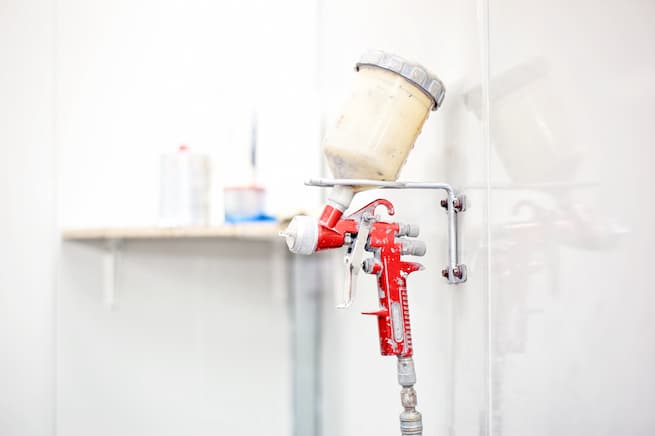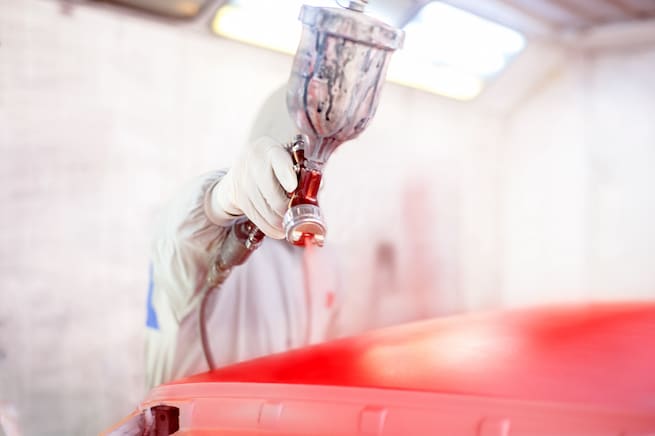7 Reasons Explaining Why Is My HVLP Spray Gun Spitting
Are you one of those people asking yourself why is my HVLP spray gun spitting? Does your turbine get too hot? Are you having trouble getting the perfect spray pattern and smooth finish you want?
Join me as I answer these and other important questions in this ultimate troubleshooting guide for HVLP (High Volume Low Pressure) paint sprayers.
HVLP paint sprayers are popular among professionals, automotive painters, and home DIY enthusiasts because they are easy to use and provide consistent finishes. Whether you have a turbine-driven unit or a single gun with a compressor combo, these sprayers offer simplicity and reliable results.
Unless something goes wrong, they require little preparation time, minimize overspray, and save you both time and money. Keep reading to learn how to fix many of the problems you might encounter with an HVLP sprayer or paint gun.
7 Reasons That Explain Why Is My HVLP Spray Gun Spitting

HVLP guns produce minimal overspray when you are finished spraying with HVLP units, whether powered by turbines or compressors, which are great tools for painting and can be used by both amateurs and professionals.
They come in various sizes, from large pneumatic guns to smaller handheld units, to accommodate different painting projects. If you encounter any issues with your HVLP unit, here are some simple solutions you can try.
#1 No or Low Paint Flow
It can be frustrating when you’re all set to spray paint and discover the paint isn’t coming out properly. There could be several reasons for this problem, so here are some remedies you can attempt:
- Insufficient paint from the paint guns: Adjust the paint control knob to the correct setting.
- Clogged nozzle: Remove the nozzle and clean off any dried paint or debris.
- Blocked suction tube: This is also a simple cleaning issue. Take out the tube and clear any blockage.
- Clogged suction tube air vent: Use a soft-bristled brush to clean the vent.
- Paint flow set too low: Increase the material flow.
- Loose suction tube air vent: Ensure the suction tube is tightly connected.
- Paint container fails to build pressure: Make sure the paint cup is properly threaded and tightly secured.
- Malfunctioning air valve tube: Verify that the valve seal is in place and that both ends of the valve are securely connected.
- Missing nozzle seal: Sometimes, these seals can come loose and get lost during cleaning. If this happens, replace the nozzle.
- Clogged air filter: Remove and replace the filter with a new one.
- Paint material is too thick: Follow the manufacturer’s instructions to thin the coating.
#2 Paint Leakage
Apart from wasting paint and costing you money, leaks from your paint system indicate something is wrong. Fortunately, most of these issues can be resolved with minimal effort:
- Loose nozzle: Tighten the nozzle.
- Worn nozzle: Replace the nozzle with a new one.
- Worn nozzle seal: Inspect the seal and replace the nozzle if it’s worn or missing.
- Dried paint on the nozzle or air cap: Clean the nozzle components to remove any paint build-up.
- Loose guide nut: Tighten the loose nut to prevent leaks.
- Worn guide washer: Replace the washer.
- The guide washer is too tight, preventing the needle from seating properly: Loosen the guide washer.
- Broken spring in the needle assembly: Replace the spring.
- Damaged or scored needle: Insert a new needle.
#3 Sprayed Material Runs or Sags
It can be frustrating when the paint starts to run or slide down the wall, ruining the surface you just painted. There are a few reasons why this might be happening, and here are some solutions you can try:
- Material flow is set too high: Reduce the amount of paint being delivered.
- Insufficient air to properly atomize the material: Increase the air power.
- Applying too much material: Speed up the movement of your spray gun or reduce the amount of coating being applied.
- Blocked nozzle: Remove the nozzle and clean off any debris or dried paint.
- Clogged air filter: Check the filter and clean or replace it.
- Insufficient pressure in the paint container: Ensure that the paint container is tightly fitted.
- Material is too thick: Dilute the coating following the manufacturer’s instructions.
- Material is too thin: Use a spray tip that is smaller or check the thickness of the paint using a viscosity cup. You might have thinned it too much.
- Incorrect angle or distance when holding the spray gun: Adjust your spraying technique and maintain the recommended distance from the surface (according to your spray gun guidelines), usually between 4 to 10 inches.
- Excessive overlap: Overlap should be about one-third of the width of your spray pattern. Also, remember to trigger on and off at turns.
#4 Pulsating Spray Jet
When spraying paint, you want a steady and continuous stream of material to achieve a good finish. If you notice that the spray jet is fluttering inconsistently, try the following fixes:
- Running low on paint: Refill the container with the material.
- Clogged air filter: Replace the air filter if needed.
- Disconnected air valve tube: Verify that both ends of the tube are properly attached and secure.
- Dirty or damaged needle or spray gun’s nozzle: Clean these parts and replace them if necessary.
- Missing or dirty paint lid gasket: Inspect the washer on the paint lid for any damage or debris. Replace or clean it as needed.
#5 Excessive Overspray
One great thing about HVLP spray guns is that they produce less overspray. However, if you’re experiencing the paint spraying everywhere, it could be because:
You’re holding the gun too far from the surface: Get closer to the area you’re painting (follow the recommendations for your specific spray gun model).
Too much air pressure: Lower the air power setting.
#6 Patchy or Light Paint Coverage
To achieve a professional-looking finish, it’s important to have even coverage without gaps or the original coating showing through. Here are some reasons why this might happen and what you can do:
- Slow down your spray gun movement: If you move too fast, the paint will be spread too thin.
- Increase the material flow: A low setting won’t provide enough coating.
- Reduce the air pressure: Excessive air pressure affects atomization.
- Keep the air cap clean and replace it if damaged: Keeping components free from debris and dry paint is essential. Make sure the air cap is in good working condition.
#7 The pattern is Heavy on Top or Bottom, or Left or Right
If you notice that more paint is applied to the edges of your spray pattern, there could be two reasons for this. Here are the causes and their solutions:
Partially blocked air cap
Spray a test pattern, then turn the air cap halfway and try again. There is a blockage in the air cap if the defect moves. If the air cap needs to be cleaned or replaced, do so.
Obstruction or debris on the paint tip or air cap seat
Remove any dried paint from the air cap and the paint tip. Wet or dry sandpaper of grit 600 can be used to smooth out the tip if it has a fine burr.
#8 Spray Gun is Spitting
A lot of people can’t figure out why their HVLP spray gun keeps spewing. When the air gets in between the spray tip and the air cap, this happens. Please verify:
Pick-up tube
Ensure it is securely connected and fully immersed in the paint.
Paint cup
Check that the cup is threaded properly onto the paint gun and tightly secured.
Fluid nozzle
Make sure it is tight and not worn, as air can enter through it.
Packing nuts and packing
Check that the packing nut is secure and that the packings are in good shape.
Connecting hoses
Look for any holes or cracks in the hoses. Replace the air hose if necessary and ensure all connections are tight.
Addressing these issues can minimize overspray, achieve better paint coverage, maintain an even spray pattern, and prevent HVLP spray gun spitting.
HVLP Spray Gun Troubleshooting

The material knob prevents too much pressure from coming out of your new fluid tip.
If you’re using an HVLP spray gun attached to an air compressor and encounter some issues, don’t worry! I have some tips and tricks to help you out.
#1. HVLP Guns Won’t Spray
To create a fine spray of paint, you need air pressure. Here are a couple of things to check if the gun isn’t spraying:
If there is no pressure coming out of your gun, check to see if the air supply is on and if the airlines are connected and undamaged.
The fluid needle adjustment screw needs to be opened up so that more paint can flow through.
The material is too dense to be fed via suction; raise the fluid pressure in the tank and check that the suction feed air cap is properly installed. Paint can be diluted with water, or a pressure-feed paint cup can be used.
#2. HVLP Spray Guns Are Spitting
You’ve set up your HVLP paint sprayer and are ready to start, but you notice that the material is not flowing through the system properly, even though it’s set to PRIME. The most common cause of this issue is a blockage somewhere in the system. Check the following parts:
Wrong needle fitted to the spray gun: Use the correct needle and tip for your spray gun by consulting the manufacturer’s chart.
Worn needle: If the needle is dull, you should get a new one.
Worn fluid tip: Replace the fluid tip with a new one.
Improperly fitted fluid tip, causing paint buildup in the air cap: Tighten the fluid tip and ensure it’s properly seated.
Clogged fluid tip: Fix a clogged fluid tip by removing any dirt, dried paint, or other debris.
#3. Air Cap Leaks When Gun Isn’t Triggered
When you’re not pressing your spray gun’s trigger, air shouldn’t be escaping from the spray tip. If you notice air leaking, follow these steps:
The air valve, seating, and shaft must be removed and cleaned if you want to ensure a tight seal.
By applying these troubleshooting steps, you can overcome common issues with HVLP spray guns and continue your painting tasks successfully.
#4. Major Material Leak or Coating Jetting From Fluid Tip
While a small drip may be annoying, a significant leak from your spray gun can be concerning. Fortunately, you can take steps to fix the issue and get your spray gun working properly again. Here are some common causes and solutions for this problem:
Contaminated needle, tip, or seat causing a poor seal: Remove the tip and needle from the gun and clean them thoroughly, along with the internal surfaces of the gun that come into contact with them.
Incorrect fluid tip for the fitted needle: Verify that the needle and tip of the new spray gun you’re using are compatible in terms of size. This will help you achieve the desired spray pattern when using your HVLP gun.
The fluid needle is stuck or not moving smoothly: Clean the fluid needle and shaft and ensure they move freely. If needed, lubricate and loosen the packing around the needle.
Last Updated on: March 16, 2025

